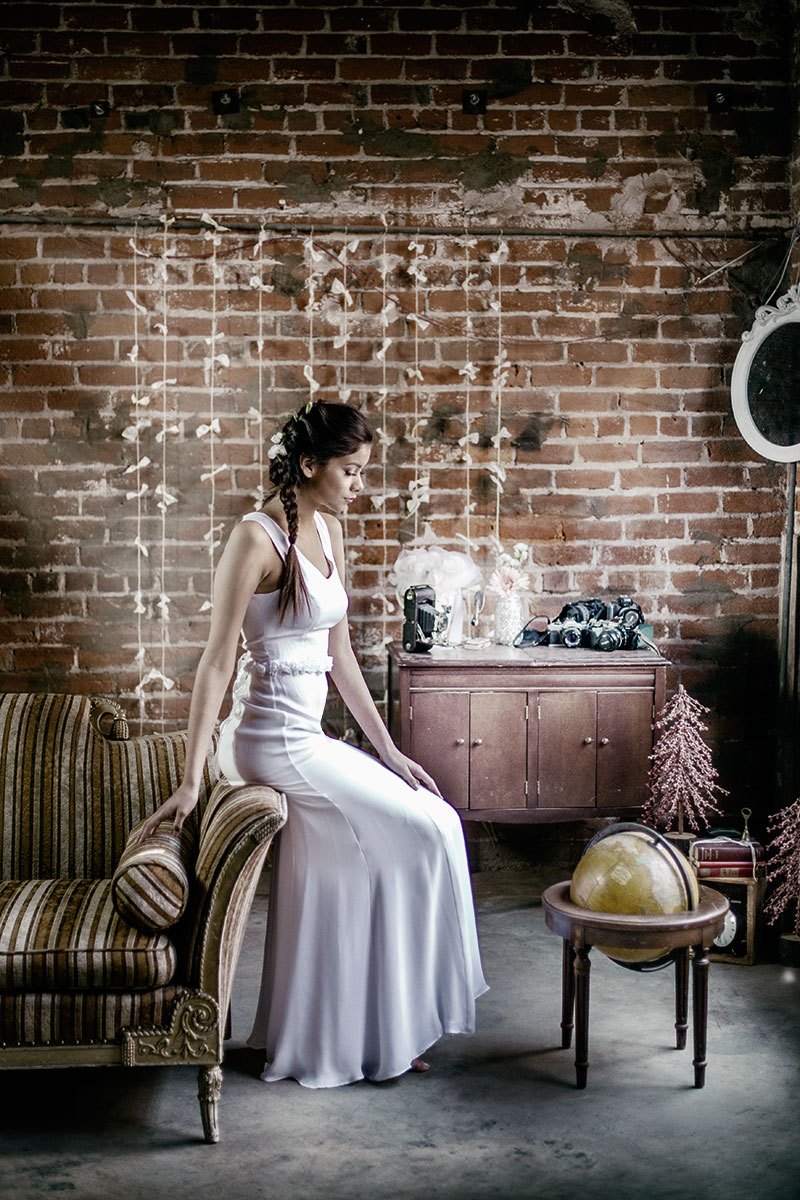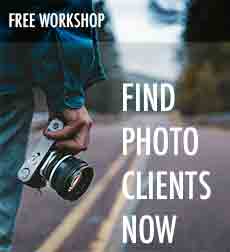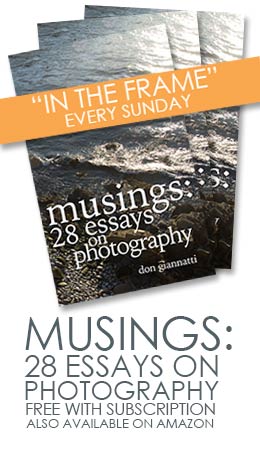
In the ‘business’ of photography some things have changed drastically since I started out a long time ago. From “day rates” to “snip tests” some of what we did as a normal part of our creative lives have either vanished or have been recreated into some new language – “TFP” will always be ‘testing’ to me.
What you shot helped determine a lot about your style, and helped clients understand what you do.
Don Giannatti: Landscape photographer
Don Giannatti: Fashion photographer
Don Giannatti: Architectural photographer
Hell – we had those designations ON our business cards… it was WHAT we shot.
And for a wide swath of the industry, it was enough. Clients wanted a photographer to do THAT thing – and you did THAT thing so you got the gig.
But not anymore. It is no longer good enough to simply shoot what you shoot. It is far more important HOW you shoot what you shoot.
Style
One of the most difficult and challenging things we deal with as photographers is style. It is a defining point of our work. It is one of the things that will set our work apart from the other photographers out there. Style will be our calling card, the incredibly complex nature of our style will be the simplest thing people see. Our work.
And yet style cannot be taught, nor would you want it to be. It shouldn’t be contrived, forced, manipulated or fake. It has to be authentic. And that can be one of the biggest challenges a photographer can face.
Let’s get a few things out of the way first. You must be a shooter first. That means that the technical stuff isn’t getting in the way. You can light what you want, and can create a shot under duress and deliver an excellent result every time. Well, if not excellent then really really really good.
We have to discover what it is you love to shoot. That may sound easy, but it can take a lot of personal introspection to find that inner driving point that makes it all come together. We will look at a few ways to get yourself directed toward the kind of work that you really love to do. And doing what you love is such a great way to make a living as a photographer.
Questions to Answer
Is it time? Could you cut out some television, or weekend projects? Could you get one shot a weekend done while still spending time with family or obligations? Can you plan very tightly to keep yourself focused on a shot per weekend?
Is it money? Are there ways to do what you do without spending money? Portraiture or street shooting shouldn’t cost at all? Can you find people and partners who can work with you to get what you need without spending money? Are there ways to piggyback tripos out of town with a few hours or a day shooting?
Is it gear? Naw… that doesn’t fly with me. If you have a camera, you can make photographs. Now, sure… you may want to create rockstar shots with 12eleventy lights and trestles and gaffers and grips. Well… that ain’t gonna happen. But if you have a camera, you can use available light, bounce cards and great ideas to get to done on the making pics thing.
Are you lacking ideas? Well, this is a tough one. If you are unable to find ideas to make photographs, then you may find this a difficult business to work through. However, if you need to prime the pump so to speak – and we all have to do that at some point – hit the bookstore, grab a coffee and start looking at magazines. Look at magazines where the interest focus is NOT what you are interested in. You want stimulation? Try magazines that you have not much interest in… then when the image captures you… BAM! That is a great idea… right?
This list will be your first challenge.
Inertia. Getting moving. The first step. Work on it.
Your subject is not your style.
I’ll say it again. Your subject is not your style. Your subject is your subject. It is what you shoot. It is your choice to aim the camera in the direction of what you like to photograph is a personal choice. A choice of subject.
How you shoot it is your style. What the image looks like is your style. How it engages the viewer and creates an emotion or reaction… that is attributable to your style. You could be a classic fashion shooter or a classic architectural shooter or a classic portraitist. Classic means you have a style that you apply to what you do. If you are wild and crazy, and that look carries across the subject matter, then you have a strong style. You will be hired for How you Shoot What You Shoot, not just What you shoot.
Let’s take portraiture. You can go to department stores and get a “portrait” made. You can get a portrait made at a photobooth, or a church fundraiser, or from that nice lady who lives across the street – the one that used to sell time-shares – she has a really good camera and can snap a pic or two.
A portrait.
Or you could hire Dan Winters to make a photograph of you. Or Emily Shur. Or Scott Toepfer or Platon. The work would be the same thing genre wise… a portrait. But it would certainly not look like those department store pix. Each of these photographers would bring their style to the work… their way of seeing, their way of making an image that does more than simply capture your image on a sensor.
And let’s be perfectly clear; if your images look like they could have been taken at the local department store, there is no way in the world you are going to be successful on any level but that… $29.95 packages of forgettable pictures.
I had a photographer who was quite frustrated come to me once and ask “what am I doing wrong?” He could not figure out why he could not get an account that for him should have been an easy cash-flow money cow. Youth sports team photos were a great way for him to stay busy in the traditional slow times in his city, and he was totally confused as to why he couldn’t get in the door.
“Look at these shots,” he said, “they are exactly like the other guys work and I can’t get in the door.”
I asked him to repeat what he had said because he had nailed it… that was his problem. And it wasn’t that he couldn’t get through the door, it was that his work looked just like the other guys work. Period.
And it was schlock – ten steps below what my friend was capable of doing.
I told him to make HIS shots, his way and see what happened. Take the lights and the batteries, take the booms and the stands – go the extra mile on making images that stand out. That are YOUR images, and see what happens.
He did nearly $40K that season alone.
His style resonated with the kids, and they in turn begged mom for more photos… cause they were cool.
As to how to know what your style is… well, that is a challenge. And I don’t think you should go out and seek a style. Rather your style is something that is revealed the more you shoot. We tend to gravitate toward those things that intrigue us about our own and others work.
Clarke Terry’s marvelous quote about jazz always resonates with me: “Imitate. Assimilate. Innovate.” And I think it is true in photography as well.
Naturally gravitate toward someone who’s style you love and find if it works for you. Imitate.
Learn to shoot in that style until it is second nature. Assimilate.
Break through and add your own twists, turns, runs, and personality to the work. Innovate.
Imitating and assimilating are easy. There are so many clones of great photographers it is sometimes difficult to see past the facade. Innovating his hard.
But necessary.
Your style is revealed by looking back, not determining forward. Style should not be contrived or artificial, it should be an organic part of your process.
And it is NOT what action or plugin you are using in Photoshop or Lightroom. C’mon… if your style is dependent on a $60 piece of software, you have no style at all. You have a gimmick.
An exercise if you are interested
Take ten of your favorite photographs by someone you admire style-wise and in your journal make comments on the following:
What kind of lighting is predominant?:
- Natural
- Appears natural
- Dark and Moody
- Single Light
- Multiple Lights
- Location Heavy
- Studio Heavy
Add any additional criteria you want to add. Note all things that are the similar in the work.
How does the photographer handle composition?:
- Classical
- Funky
- Off Kilter
- In Close
- Far Away
- Horizontal Prominent
- Vertical Prominent
- High Angle
- Low Angle
Add any additional criteria you want to add. Note all things that are the similar in the work.
What kind of post production do they do?:
- Heavy Post
- Medium Post
- Minimal Post
- No Post.
Add any additional criteria you want to add. Note all things that are the similar in the work.
At this point it is important to note that we are not caring about subject matter. We are looking at ways photographers create a style. It may not be a style that you are interested in or it may be such a blast that it makes you want to shoot like that. Cool. You can’t copy, you can only work through it as an inspiring model.
And that is so true. Taking the time to do this with a couple of the names above is a great way to see how photographers work within parameters they set themselves. Don’t do all of them, but do a couple for sure. I suggest that you use one or two of the photographers you love. And do one or two of those shooters who may not be your cup of tea. It is a great exercise. Sharpens the mind.
NOW DO IT AGAIN WITH 10 OF YOUR IMAGES.
This can be quite an eye opening exercise – and it can be done by photographers of every level.
If you have been shooting for only a couple of years, it may be entirely possible that you do not have a style yet. Or if you do you are still in the Assimilate stage. Finding your own voice, one that resonates with your heart and mind is the most important part of all of this process of professional photography.
There are legions of mediocre photographers out there crying the blues because they cannot get a gig – remember the story of my friend. If your work is stylistically the same as 8 dozen other photographers, there is a great chance that no one cares. You haven’t given anyone a reason to care.
Give them a reason to note your work. Give them a reason to champion your imagery. If you cannot do that, then give them an estimate that’s $5 less than the other photographer that shoots the same way you do.





Good one again Don, maybe it’s even the best (in: most gracious) one so far. Thanks for all the good advice, and have a happy and great new year.